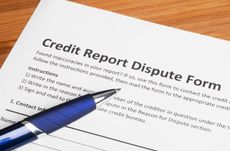Understand Your Credit Utilization Ratio
It's important to keep this ratio low, especially if you plan to apply for a loan soon.


If I pay off my credit card balance in full every month, does that mean I have a 0% credit utilization ratio?
No, although this is a common misunderstanding. Your credit utilization ratio is based on the amount of available credit that you used over the billing cycle. So if the limit on a card is $20,000 and you’ve charged $5,000 when the numbers are reported, then your credit utilization ratio for that card is 25%, even if you pay the $5,000 in full by the due date. Your total credit utilization ratio is calculated by dividing the total amount you have charged by the total of your credit limits. Lenders look at your total credit utilization ratio across all of your cards, as well as the ratio for each card.
Your credit utilization ratio is based on the information the bank provides to the credit reporting agency. “Whatever balance shows up on your credit report is what’s used in the utilization calculation,” says John Ulzheimer, credit expert at CreditSesame.com. That figure is generally the previous month’s balance that appears on your statement, even if you pay the bill in full by the due date.

Sign up for Kiplinger’s Free E-Newsletters
Profit and prosper with the best of expert advice on investing, taxes, retirement, personal finance and more - straight to your e-mail.
Profit and prosper with the best of expert advice - straight to your e-mail.
You can achieve a 0% utilization ratio if you plan in advance. Ulzheimer recommends paying off the total balance on each of your cards at least two billing cycles before you apply for a mortgage, or paying off the balance in full by the statement closing date (you can find the closing date on your statement or by contacting your credit card company). “The statement closing date is the end of the 30-day period in which activity on the account is tabulated and the new statement balance is calculated,” he says. “By paying off the balance by the statement closing date, the statement will show a zero balance, which means your credit reports will also show a zero balance for that account.”
In addition to reducing your total utilization ratio as much as possible before applying for a mortgage, it’s wise to keep your total ratio and the ratio for each credit line below 30% at all times, says Chris Mettler, president and founder of CompareCards.com. “Remember: It is not the total amount of debt that matters, but the percentage of available credit that you are currently using,” he says.
For more information, see 9 Secrets to Better Credit.
Get Kiplinger Today newsletter — free
Profit and prosper with the best of Kiplinger's advice on investing, taxes, retirement, personal finance and much more. Delivered daily. Enter your email in the box and click Sign Me Up.

As the "Ask Kim" columnist for Kiplinger's Personal Finance, Lankford receives hundreds of personal finance questions from readers every month. She is the author of Rescue Your Financial Life (McGraw-Hill, 2003), The Insurance Maze: How You Can Save Money on Insurance -- and Still Get the Coverage You Need (Kaplan, 2006), Kiplinger's Ask Kim for Money Smart Solutions (Kaplan, 2007) and The Kiplinger/BBB Personal Finance Guide for Military Families. She is frequently featured as a financial expert on television and radio, including NBC's Today Show, CNN, CNBC and National Public Radio.
-
 States That Won't Tax Your Retirement Income in 2025
States That Won't Tax Your Retirement Income in 2025Retirement Taxes Several states don’t tax Social Security benefits, 401(k)s, IRAs, and pensions. But you may still have to pay state taxes on some incomes.
By Kate Schubel Published
-
 Build Your Dream Retirement With These Five Steps
Build Your Dream Retirement With These Five StepsDreaming about life after work? Turn your dreams into a concrete, actionable plan by nailing down the why, what and how of your retirement.
By Keith Wiltfong, CFP®, CIMA® Published
-
 Credit Report Error? They All Matter
Credit Report Error? They All Mattercredit & debt Don't dismiss a minor error. It could be the sign of something more serious.
By Kimberly Lankford Published
-
 Insurance for a Learning Driver
Insurance for a Learning Driverinsurance Adding a teen driver to your plan will raise premiums, but there are things you can do to help reduce them.
By Kimberly Lankford Published
-
 529 Plans Aren’t Just for Kids
529 Plans Aren’t Just for Kids529 Plans You don’t have to be college-age to use the money tax-free, but there are stipulations.
By Kimberly Lankford Published
-
 When to Transfer Ownership of a Custodial Account
When to Transfer Ownership of a Custodial Accountsavings Before your child turns 18, you should check with your broker about the account's age of majority and termination.
By Kimberly Lankford Published
-
 Borrowers Get More Time to Repay 401(k) Loans
Borrowers Get More Time to Repay 401(k) Loansretirement If you leave your job while you have an outstanding 401(k) loan, Uncle Sam now gives you extra time to repay it -- thanks to the new tax law.
By Kimberly Lankford Published
-
 When It Pays to Buy Travel Insurance
When It Pays to Buy Travel InsuranceTravel Investing in travel insurance can help recover some costs when your vacation gets ruined by a natural disaster, medical emergency or other catastrophe.
By Kimberly Lankford Published
-
 What Travel Insurance Covers When Planes Are Grounded
What Travel Insurance Covers When Planes Are GroundedTravel Your travel insurance might help with some costs if your trip was delayed because of the recent grounding of Boeing 737 Max planes.
By Kimberly Lankford Published
-
 Ways to Spend Your Flexible Spending Account Money by March 15 Deadline
Ways to Spend Your Flexible Spending Account Money by March 15 Deadlinespending Many workers will be hitting the drugstore in the next few days to use up leftover flexible spending account money from 2018 so they don’t lose it.
By Kimberly Lankford Published